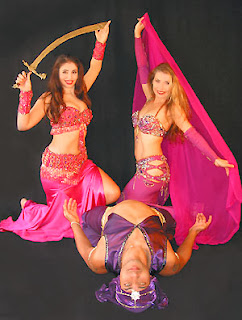BELLY DANCE WORLD

Friday, November 29, 2013
HISTORY OF GOTHIC BELLY DANCE IN CALIFORNIA USA
Originating in the Middle East, South Asia (India), and North Africa,[citation needed] the art of belly dance arrived in the West with the trend of Orientalism. Exotic to the Western eye and mysterious in its roots, belly dance has always attracted interpretive dance artists who have woven it into trends of Western culture. The new millennium brought a revival of popular interest in Goth subculture and Gothic art motifs in dance, and a new interpretive style, Gothic belly dance, was propelled to prominence.
Dance publications started exploring this new phenomenon, thousands of Gothic belly dance enthusiasts have subscribed to online discussion groups dedicated to this genre, leading artists started traveling across the US and overseas with workshops and tours, featuring Gothic belly dance performances, and instructional materials have appeared on retail shelves.
Gothic belly dance was born in the early 1990s all over the world, US urban centers as a blend of Goth and world music, the movement vocabulary of belly dance and other dance forms, and Gothic fashion and aesthetics. Performing at Gothic-themed events and Goth clubs, dancers started to explore Goth music and adopt costuming styles incorporating Victorian, vampire, dark cabaret, silent-movie vamp, industrial, and other visual themes related to Goth subculture.
Although the concept of 'Gothic belly dance' may have originated in the US it is not just a US phenomenon. The UK and Germany has had Gothic belly dancers for many years as in Goths who are also belly dance teachers and performers and have been 'dancing darkly' at Haflas and other events for a long time. These dancers did not have as much of an outlet for their styles as they do now and perhaps not even a label for what they did. Partly thanks to links through the web and the GothIC festival, Gothic belly dance is recognzed in many countries.
The 21st century[edit]
As a modern and versatile world dance genre, belly dance has evolved into an array of interpretive dance sub-styles compatible with modern music and imagery. Dancers performing Gothic belly dance usually retain their preferred technique — mostly modern cabaret and tribal fusion belly dance — but also bring new emphasis to the dramatic and theatrical features of their dance to match the intensity and vibe of Goth music.
Gothic belly dance discussion groups hosted by tribe.net, MySpace, and other online community sites connected dancers from around the world, making possible workshops and tours, and helping this new genre to solidify and gain recognition within the larger dance community. In addition, the rapidly expanding global access to free online video resources at YouTube and similar sites has allowed artists to unify and combine their efforts in promoting and developing their genre — unconstrained by national borders, scarcity of funds, or lack of support from their local communities.
In 2007 Southern California-based dancers and instructors, Tempest and Sashi, launched the annual Gothla, described by the L.A. Weekly as "a 'gothic hafla' that combines weekend-long workshops with a Saturday festival featuring twelve hours of performances and merchant booths where dancers can find costumes and accessories. Gothla US 2009 took place March 6–8 at Cal Poly Pomona.
Gothla UK was also first held in 2007, in Leicester, England, and is now a highly successful festival covering three days, usually in July. International teachers are joined by UK teachers such as Lucretia (Christine Emery), Fulya (Lynn Chapman), and Akasha (Heike Humphreys) to offer a range of themes not often covered by general belly dance events from steampunk and 1920s to zombie and vampire belly dance.
Belly Dance is an exotic art flourishing in the wetern world with many new names,styles and versions but only common
Thing remains is the REAL SPIRIT OF BELLY DANCE
Subscribe to:
Post Comments (Atom)

No comments:
Post a Comment